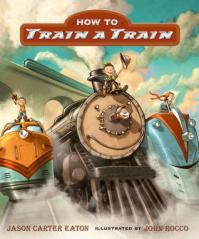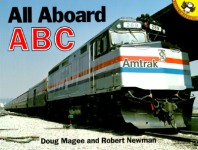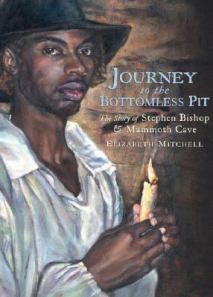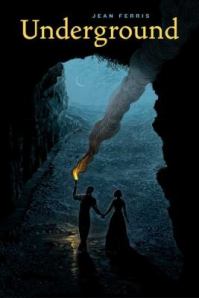It’s no secret that train books are hugely popular with boys, including the many Thomas the Train titles as well as lots of other great picture books, both fiction and non-fiction. Here’s a new one that’s unique in perspective, with excellent artwork:
 How to Train a Train, by Jason Eaton (lexile: NA; AR book level: 3.0; 48 pp)
How to Train a Train, by Jason Eaton (lexile: NA; AR book level: 3.0; 48 pp)
“So you want a pet train? Well, of course you do!”
So begins the pith-helmeted young narrator of this delightful new picture book, a guide to finding and training your very own pet train! He starts with suggestions for catching a wild train (offer it some coal), continues with ways to calm a nervous train (a warm bath), help it get to sleep at night (a story or some locomotive music), and teach it tricks. The suggestions are absurdly funny, but what really makes this book are John Rocco’s outstanding illustrations. The trains are big, with mechanical faces that give them personality and emotion, and the kids show obvious love for their big iron pets.
**********
There are plenty of great non-fiction train books for young readers, but here are two in our library that I really like because the photography is so good:
 Steam Train Ride, by Evelyn Clarke Mott (lexile: NA; AR book level: 2.7; 32 pp)
Steam Train Ride, by Evelyn Clarke Mott (lexile: NA; AR book level: 2.7; 32 pp)
Take a fun trip with preschooler Christopher on a steam train. Amply illustrated with photos, the story follows Christopher as he meets the engineer, learns a bit about how the engine works and what the signs mean along the track, buys a ticket, and takes a trip through the countryside on the train.
 All Aboard ABC, by Doug Magee (lexile: NA; AR book level: NA; 43 pp)
All Aboard ABC, by Doug Magee (lexile: NA; AR book level: NA; 43 pp)
A typical ABC book, with something about trains for each letter of the alphabet. The excellent photos take up most or all of a page, and portray items from a variety of perspectives. Young train enthusiasts will especially enjoy the close-ups of mechanical parts like the coupler, springs, and switches. The text provides simple, clear explanations in an easy-to-read font. This would be great to read with a child preparing for a train trip or visit to a railway museum.


 Journey to the Bottomless Pit: The Story of Stephen Bishop & Mammoth Cave
Journey to the Bottomless Pit: The Story of Stephen Bishop & Mammoth Cave Underground
Underground How BIG is it? A BIG Book All About BIGNESS
How BIG is it? A BIG Book All About BIGNESS Never Smile at a Monkey: And 17 Other Important Things to Remember
Never Smile at a Monkey: And 17 Other Important Things to Remember Amazing Rubber Band Cars: Easy-to-
Amazing Rubber Band Cars: Easy-to-
